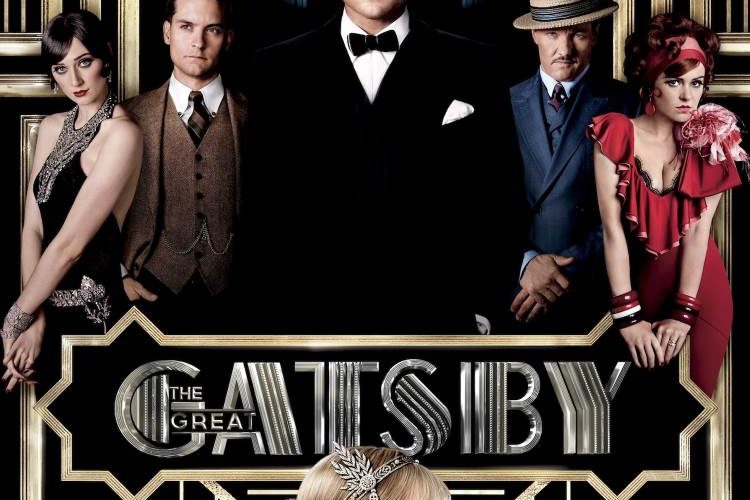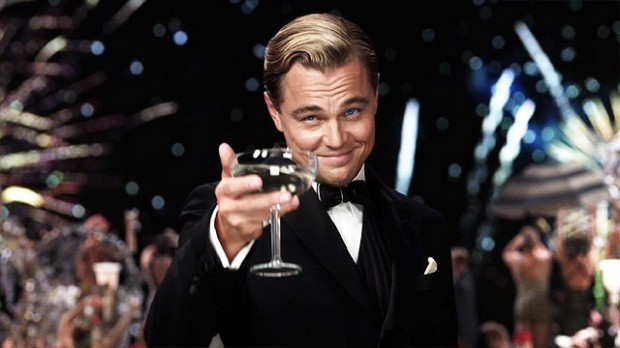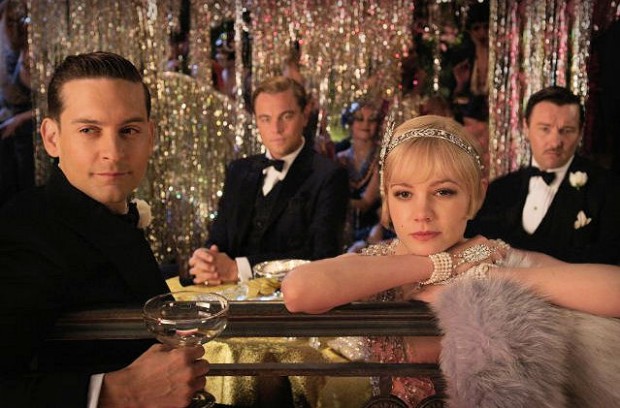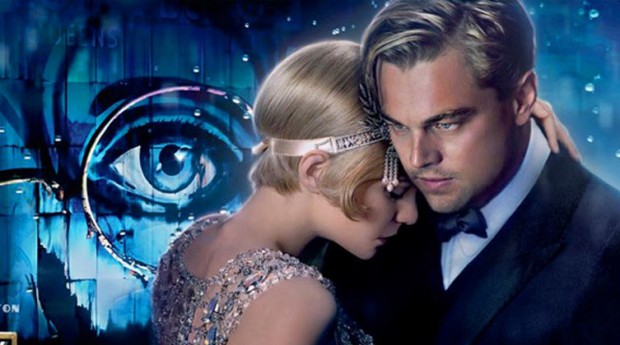Baz Luhrmann’s spectacle-drunk adaptation of The Great Gatsby is exactly what its pedigree and trailers have suggested; a big hot mess that indulges its director’s penchant for lush, decadent imagery and grand romantic pronouncements. Whether you personally consider that a good thing or a bad thing may directly relate to what you think of F. Scott Fitzgerald’s classic novel, and how willing you are to let Luhrmann take you on his visually tasty tour of the roaring twenties. As a Luhrmann movie, it’s all the usual giddy glitz with a dash of cinematic maturity. As a worthy distillation of Fitzgerald, it’s mostly, as Daisy Buchanan might say, “a beautiful little fool.”
If Baz’s film fails to actually grasp what the fickle object of Gatsby’s affection means when uttering that famous line to cousin Nick Carraway, it’s decidedly more confident in visualizing the excessive fairy tale indulgences of Fitzgerald’s towering prose. Glaring flaws aside, this is a much more interesting adaptation than Jack Clayton’s blandly reverant take, and there’s value in the fact the target audience seems to be those underwhelmed high-school students who have already confronted the novel in English class. Configured at the center is Leonardo DiCaprio, who may not sufficiently establish Gatsby’s virtues but delivers a sturdy showing anyway, evoking Jay’s jittery insecurity masked as new-money ambivalence with the same outsized energy Luhrmann applies to the film itself.
Telling the story of a self-made millionaire who’s driven by the love he lost, the print version of Gatsby was a poetic and insightful snapshot of a particular moment in our social history, a catalogue of frivolity and vapid high-society values proven to be anything but. Jay Gatsby’s unflagging quest to win back his now married Daisy was a decisive plot point that only inflamed and enlarged the book’s sense of mystery and secret yearning. As observed by the star-struck Nick Carraway, Gatsby’s neighbor, friend and incidental biographer, the simple story became a portrait of a lonely man’s bid for acknowledged worth in the eyes of those he loved, matching glittering hollow empires with the arrogant stewards of old money like Daisy’s husband Tom Buchanan. While Tom pursues the pleasures and whims of his own enormous appetites with mistress Myrtle Wilson, Daisy skirts with the notion of returning to Gatsby’s arms, halted by the fact she’s less reliable and far less worthy than the pure dreams that have driven her unwavering admirer. The ultimate fates of those involved play less as tragedy and more as the expected trajectory of all brightly burning things, each destined to whiff out eventually.
Onscreen, Luhrmann reconfigures it as a strange, idosyncratic graphic novel, boiling down the potent imagery into breathtaking but ephemeral set pieces and easily digested visual motifs, bolstered by a searing, even transporting, anachronistic soundtrack presided over by Jay-Z. His Gatsby is decidedly faithful to the novel’s version of events, and its adherence to Fitzgerald’s iconic dialogue creates a backbone for the opulent and hyperactive sensory explosions that litter the first half. As an enticing, aesthetic exercise, The Great Gatsby may be Luhrman’s finest accomplishment since his quirky and exuberant Aussie dance comedy Strictly Ballroom. From the opening shots that transform the Warner Bros. logo into the three-dimensional architecture of Gatsby’s world, Baz lets his overheated imagination run wild with the exhausting whirl of the parties at the mansion in West Egg, or the grim, near-apocalyptic squalor of the “valley of the ashes.”
During the day brightly colored roadsters race along the sun-dappled roads leading to Gatsby’s cloistered castle, and the nights are wilder yet, with bachannales so indulgent that the camera frame is crammed full like a Where’s Waldo? illustration. At times Luhrmann pulls back and tries to settle in to the dramatic spaces of the stories, often by oscillating between reckless pop imagery and classically coiffed Old-Hollywood grandeur. When these scenes work the film lets us into its emotional storerooms, when it doesn’t it feels like Baz is holding a Michael Bay movie in one hand and a Lars von Trier movie in the other, mashing them together and making kissy noises.
Sumptuous just isn’t enough for a successful tackling of Gatsby, and that’s where Luhrmann’s movie ultimately falters. The acting is hit or miss depending on the character being tackled and how each performer interprets them. As mentioned, DiCaprio does a nice Gatsby, although his grotesquely excessive use of ‘Old Sport’ is likely to soon summon its own meme. He’s not the novel’s Jay Gatsby but he’s tuned into this film’s vision of him as a fragile but hopeful opportunist. Carey Mulligan enters the film emerging from a delicate coccoon of billowing white silks and her sketching of Daisy never much leaves this image. This Daisy is an emotionally messy and callow child, who doesn’t possess enough poise or yearning to make us think a man like Gatsby would have done half of this for her. Mulligan is good in the role but it doesn’t ring true; it’s the wrong performance, not the wrong actress.
Tobey Maguire’s Carraway was never the most insisting character in the book, but his involvement was omnipresent because we only ever view Gatsby through the mirror of his words. Capturing him as his own agent is a difficult task for a film version, and Maguire is too slight and doughy to make any real impression. He’s at the edge of every scene, but he’s about as proactive as the chandliers and giant paper moths that adorn the pricey shindigs. Ultimately, it’s the secondary tier of actors and characters that shine most brightly. Joel Edgerton may be an Aussie, but he’s cracked Tom’s brutish exterior and also found his assuming but soft interior as a priveledged American son who believes the world exists to furnish him with satisfaction. Without Edgerton commanding the second half, Luhrmann’s flaky pastry would blow away with the film’s August winds. My favorite work in the movie is Elizabeth Debicki’s effervescent Jordan Baker, the tall, elegant golf star who takes a shine to Nick in the novel, but is mostly in the film as a bubbly, invigorating mouthpiece. Also given short narrative shrift but placated with a wonderful showcase is Meyer Wolfshiem, Gatsby’s questionable business associate, played here by Bollywood veteran Amitabh Bachchan.
There is no denying that this sweeping, sweating, gyrating collage is a pleasure to look at, but it’s also simultaneously disappointing that icons looming in our mind’s eye—Fitzgerald’s self-proclaimed enchanted objects—are realized here in such kitschy fashion. Amongst those diminished totems are the great lonesome eyes of Dr. T.J.Eckleberg, once the judging gaze of an absent God, now just a tacky billboard, and the light at the end of Gatsby’s pier, the novel’s gravitational metaphor now resembling a Martian death ray emenating across the water.
In fact, all of The Great Gatsby suffers a similar downsizing. As an event blockbuster culled from one of the greatest American novels, Luhrmann’s film is relievingly ‘not awful’ and goes as far as to often be delicious entertainment. In the end, the director has done his job just a little too well, pressing down the curling edges of Fitzgerald’s tantalizing contradictions until he’s completely flattened them into a comic strip. Enter the ultimate summer movie experience; Archie, Jughead and Veronica re-enact The Great Gatsby in 3D.
The Great Gatsby hits theaters on Friday, May 10th.




